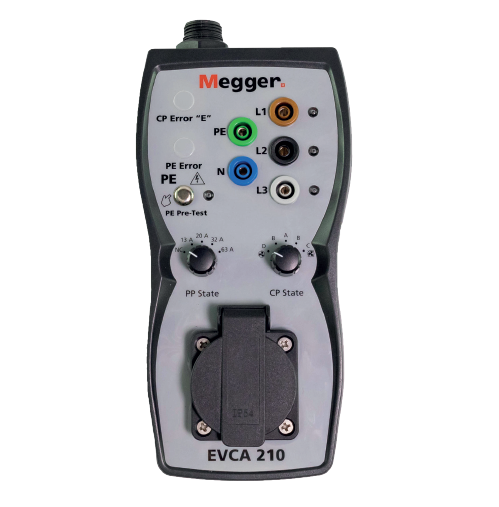The EVCA210/EVCA210-UK may be used on all single and three phase electric vehicle charge points, with appropriate connectors.

The Megger EVCA210/EVCA210-UK are compact, simple to use adapters designed to perform all the functions required by the electrical contractor to fully test Mode 3 AC Electric Vehicle Charge-points.
Specially designed to comply with UK, European and other International wiring regulations and standards, the EVCA210/EVCA210-UK may be used on all single and three phase electric vehicle charge points, with appropriate connectors. They are designed to test the function and safety of a charging point. The adapters allow you to conduct tests using appropriate single or multifunction test instruments on EV charging points in accordance with IEC/EN 61851-1 and IEC/HD 60364-7-722. Charging points should be tested as part of the initial installation and repeated periodically.
The Megger EVCA210/EVCA210-UK test adaptors are designed to simulate the connection of an electrical vehicle to the charging point under test. Connection of the adapter enables the operator to trigger the charging process by selecting the appropriate Proximity Pilot (PP) and Control Pilot (CP) states.
Test instruments can be connected using either the front mounted mains socket or the 4mm connection ports L1, L2, L3, N, PE. 2 additional CP signal terminals give the operator the ability to measure the CP signal using an oscilloscope. In addition, the adapters have a manual PE Pre-Test feature that allows the user to test for dangerous voltages present on the PE, prior to any other testing of the charge point. If this test fails, testing must cease as potentially dangerous voltages may be present on the PE and faults must be investigated and rectified before continuing. The adapters also integrate two further manual tests: CP Error – simulates an error on the control pilot circuit; and a PE Error – where a disconnection of the PE circuit is produced.
Both test ensure correct disconnection of the output of the charge point.Before carrying out testing with this adaptor, it is recommended that the user familiarize themselves with the relevant standards:
IEC 61851-1:2017, Electric vehicle conductive charging system - Part 1: General requirements
IEC 60364-7-722:2018 Low-voltage electrical installations - Part 7-722: Requirements for special installations or locations - Supplies for electric vehicles and any documentation relating to the charging station itself.The Megger EVCA210-UK is provided with 2 connection cables as standard, a Type 2 connector for charging points with panel mounted socket outlet or fixed cable with vehicle connector and a Type 1 connector for charging points with fixed Type 1 cable connector – as found on the Mitsubishi PHEV.
The Megger EVCA210 is supplied with the Type 2 plug only.
| Specification | |
| Input voltage | Up to 250 V (single phase system) / up to430 V (three phase system |
| Input Frequency | 50/60 Hz, |
| PE Pre-Test | Yes - Push button |
| CP Error “E” simulation | Push button |
| PP Simulation | NC, 13 A, 20 A, 32 A, 63 A |
| CP States | A, B, C, D |
| CP Error “E” | Yes |
| PE Error (Earth fault) | Yes |
| Measuring Ports L1, L2, L3, N and PE | Max. 250/430 V, CAT II 300 V, max. 10 A |
| Mains socket | Max. 250 V, CAT II 300 V max. 10 A,Note: Do not load mains socket simultaneously with measuring ports! |
| CP Signal Test Ports | Approx. +/-12 V, CAT 0 (under normal condition)In case of wrong wiring or error of the charging station these terminals |
| Measurement category | CAT II 300 V |
| Altitude above sea level. | 2000 m max |
| Dimensions (W × H × L) | 225 mm x 145 mm x 62 mm (without connection cable and test cable) |
| Weight | Approx: 780g |
| IP-rating | IP54 |
| CE directive | Low Voltage Directive LVD 2014/35/EU |
| Safety | IEC/EN 61010-1:2010 IEC/EN 61010-2-030:2010 |
| Working temperature range | 0 ... +40 °C |
| Storage temperature range | -10 ... +50 °C |
| Reference humidity range | 10 ... 60% relative humidity w/o condensation |
| Working humidity range | 10 ... 85% relative humidity w/o condensation |
Contact us by filling out this form: